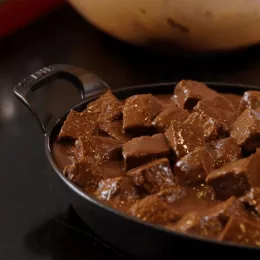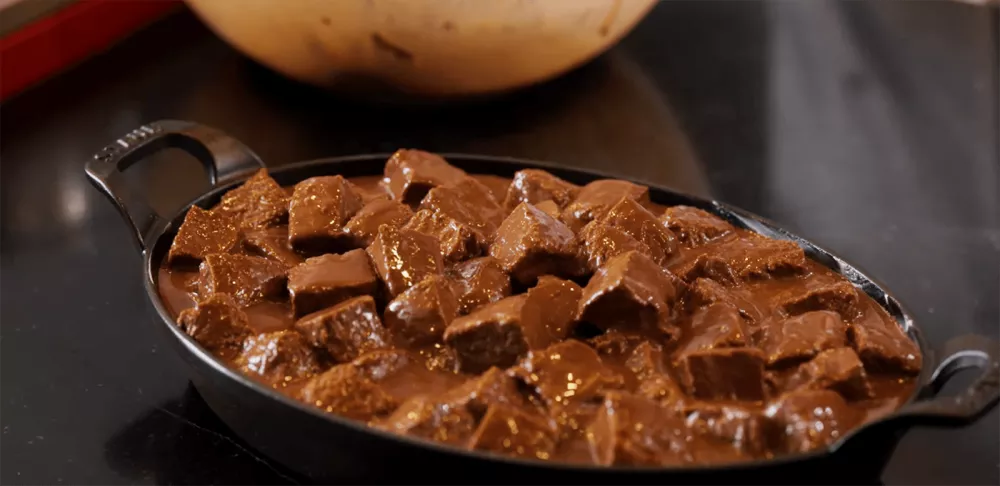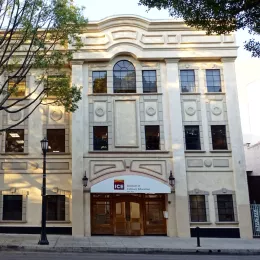“Custards are any kind of liquid that has been thickened with eggs,” Pastry & Baking Arts Chef-Instructor, Kierin Baldwin says.
In our latest partner video with Zwilling, Chef Kierin demonstrates the difference between stirred versus baked custards by way of dark chocolate bread pudding topped with a salted caramel crème Anglaise.
“The way that our main types of custard differ are essentially the way that you’re thickening your eggs,” she says.
The general rule of thumb with custards, period, is that you never want to overcook your eggs.
“We want equipment that’s going to be able to give us really nice slow, steady, even heat,” Chef Kierin says. “In the case of a boiled or a stirred custard, we want a heavy bottom pot that’s going to be able to give us evenly-distributed heat.”
Chef Kierin recommends the Demeyere Atlantis 3.2-quart sauce pan with lid to make the caramel for your crème anglaise and baking the bread pudding in a 9.5 inch Staub cast-iron oval baking dish.
Watch the video and view the recipe below.

Ingredients
For the Salted Caramel Crème Anglaise:
- 150 grams granulated sugar
- 1 vanilla bean pod, split and scraped
- 375 grams heavy cream, warmed
- 375 grams whole milk
- 110 grams egg yolks
- 6 grams salt
For the Dark Chocolate Bread Pudding:
- 1# loaves brioche, crusts trimmed
- 590 grams whole milk
- 590 grams heavy cream
- 150 grams sugar
- 15 grams cocoa powder
- 1 vanilla bean pod, split and scraped
- Fine Sea Salt 1 tsp / 5 grams fine sea salt
- 175 grams dark chocolate
- 105 grams 99% chocolate
- 9 large eggs
- 2 large egg yolks
Directions
For the Salted Caramel Crème Anglaise:
- Set aside 50 grams of the sugar.
- Preheat a heavy-bottomed stainless steel pot, and make a dry caramel with 100 grams of the sugar by sprinkling a bit at a time into the pot and stirring with a heat proof silicone spatula to melt it completely after each addition. Continue gradually melting it a bit at a time until all of the sugar has been added. Continue to cook it until it reaches a uniform deep amber color. Turn the heat off and add the warm heavy cream about one quarter at a time, stirring after each addition to prevent the caramel from seizing. Add the milk slowly and then turn the heat back on and bring up to a heavy steam, just below boiling..
- While the liquid heats back up, whisk the reserved sugar together with the egg yolks and the salt. Once the liquid is hot, slowly pour it into the yolk mixture, whisking as you add it, to gently warm the yolks. When the outside of the bowl feels hot to the touch, you can add the yolk mixture back into the pot and turn it back back on over low heat.
- Now that the yolks are in the pot, you need to stir it continuously in order to prevent the eggs from curdling. With a silicone spatula, stir back and forth from one side of the pot to the other in order to gently and evenly heat the mixture and slowly coagulate the eggs. The bubbles on the surface of the anglaise will disappear and it will let off steam but it should not boil. If you put some of the sauce on your spatula, let the excess drain for just a moment and then draw your fingertip through what is still there, it should be thick enough that it will not dribble. You can also test for doneness with a thermometer. At 175o F the sauce is fully cooked.
- Once it is fully cooked, immediately turn off the heat and pour it quickly through a fine strainer. Cool the custard down in an ice bath and then use it as a sauce or allow it to age for 12-24 hours before spinning it in a batch freezer to make ice cream.
For the Dark Chocolate Bread Pudding and Assembly:
- Preheat your oven to 325˚F. Butter a 3-quart casserole dish.
- Cut the brioche into 1/2-" cubes and spread them on a baking sheet in a single layer. Toast them until they are slightly dried out and golden. Set the bread aside to cool.
- Combine the milk, cream and a third of the sugar in a heavy-bottomed stainless steel pot and bring the mixture up to a heavy steam. Whisk together another third of the sugar with the cocoa powder. Whisk together the last third of the sugar with the salt and whisk it into the eggs and yolks.
- When the milk and cream begin to bubble, whisk in the cocoa mixture. Bring it back up to a boil and simmer for 1 minute, lowering the heat to keep the pot bubbling without spilling over. After a minute, turn the heat off and pour the hot cocoa mixture over the chocolate, whisking to melt the chocolate completely.
- Whisk the hot chocolate mixture into the eggs and then pass it through a fine strainer.
- Place the toasted bread in a large bowl and pour the custard mixture over it. Allow the bread to soak for about 20-30 minutes, gently mixing the two together every 5-10 minutes to encourage it to soak up all the custard. (Stop mixing if the bread begins to fall apart.)
- Gently spoon the soaked bread into the prepared casserole. Pour any extra chocolate custard left in the bowl over the bread slices and dust the tops of the soaked bread generously with powdered sugar.
- Place the casserole dish into a larger pan filled with enough hot water that the casserole is immersed about halfway. Bake uncovered until the custard is just barely set and the tops of the bread slices are lightly caramelized, about 45 minutes to an hour.
- Spoon bread pudding into bowl and top with crème anglaise. Serve immediately.




